The reason I haven’t posted so much in the last months was because the start of the project „Plant Food Management at Early Neolithic Göbekli Tepe“ was requesting a lot of preparations, which left me with few time for blog contributions (I’m tweeting my research step by step, though, under: @laura_dtrich).
The main aims of my research project is to reconstruct the use of plants in the food spectrum at Göbekli Tepe, the plant management strategies and the interaction between man and environment on one side, and to contribute to an explanation for the special character of the site through new insights from this point of view on the other side. The study of plant resources and plant food at Göbekli Tepe is of great importance to understand Early Neolithic subsistence in the Levant and, linked to this, economic, social and biological processes that shaped our modern world. The site covers a long time span, in which the Neolithisation, i.e. the domestication of plants and animals, took place, until a point of no return to the world of hunters and gatherers was reached.
Göbekli Tepe is a special site, most probably a central site for meetings, and a cultic place with monumental architecture. It is not likely, at the current state of research, to interpret the site as a settlement (at least not as a “classic” settlement with populations living permanently at the site). But the more or less permanent presence of groups of people, erecting monumental architecture and/or maintaining it has to be assumed, and their subsistence was most likely an important issue. Also, social events like feasting could have played an important role at the site (Dietrich et al. 2012: O. Dietrich, M. Heun, J. Notroff, K. Schmidt, M. Zarnkow, The role of cult and feasting in the emergence of Neolithic communities. New evidence from Göbekli Tepe, south-eastern Turkey. Antiquity 86, 2012, 674-695).
Plants seem to be a more stable food resource compared to the partly migratory hunted animals, and the presence of an impressive quantity of storage vessels is certainly a hint for the massive storage of plant food at Göbekli Tepe. Different approaches for a reconstruction environments and plant use exist, for example through pollen and phytolith analysis. These methods can be theoretically used, but still have some methodological problems to be solved. The reconstruction of plant food is largely based on the botanical analysis of the plants discovered at a site (in significant contexts). But objects like grinding stones can make a significant contribution to our knowledge on plant use. Macrobotanical analysis has shown the use of einkorn, emmer, barley, pistachio and almonds at Göbekli Tepe (Neef 2003: R. Neef, Overlooking the Steppe-Forest: A Preliminary Report on the Botanical Remains from Early Neolithic Göbekli Tepe (Southeastern Turkey). Neolithics 2, 2003, 13-16). However, there are only very few plant remains from Göbekli Tepe, and they are also badly preserved. The bad preservation conditions for such remains will inevitably lead to a very biased image regarding plant food at the site.
Given this situation, objects for the preparation and storage of food are a much more objective method to quantify the actual use of plant resources. There are over 10.000 grinding stones from the site. It is known from ethnographically sources that grinding stones were used for processing numerous foodstuffs (cereals, nuts, legumes, herbs, even meat, cheese or grasshoppers) but also minerals (salt, ochre), sugar and even animal skins. The processing of meat, ochre and animal skins was observed in several Epipalaeolithic sites in the Levant (Dubreuil et al 2015: L. Dubreuil, D. Savage, S. Delgado, H. Plisson, B. Stephenson, I de la Torre, Use-wear analysis of ground stone tools: discussing our current framework, in J. Marreiros, J. Bicho (Eds.) Use-wear handbook 105–158. Berlin, Springer 2015). One of the main aims of analyzing grinding stones is to deduce exactly their functions, and that can be done by analyzing their surface with the microscope for usewear; 3 D models are also useful tools for quantifications of use. Grinding different materials will produce different wear on the surface. The specific patterns of usewear traces can be compared with experimental objects (blog contribution coming up), used for grinding just one material. This is one of the best and most exact ways to deduce the function of grindings stones and, through statistically and stratigraphically secured observations, the amount of plant food in daily life.
According to (very) preliminary results, numerous grindings stones were used at Göbekli Tepe for the processing of cereals and nuts, and very few for ochre and animal skins. But a lot of work will follow to put these observations on a statistically firm basis, and – given the huge amount of information and different methods of analysis – it takes definitely more than one scientist to make (10000) stones speak!
So here is my hive mind, which made my research possible this year: Hajo Höhler-Brockmann (German Archaeological Institute), Julia Meister (Free University of Berlin), Julia Heeb (Village Museum Düppel) and Nils Schäkel (Free University of Berlin) and of course Oliver.
And here is a short history in images from the last months:

1: Sorting grinding stones in the excavation house… (photo: J. Meister)

2: Here is just a part of them! (photo L. Dietrich)

3: Analyzing the use wear with the microscope, making 3D-models and taking samples from the surface: me (left), Julia (right), Hajo (behind).
- 4: Handstone in 3D (model H. Höhler-Brockmann, copyright DAI).
- 4: Handstone in 3D with analysis of roughness (model H. Höhler-Brockmann, copyright DAI).
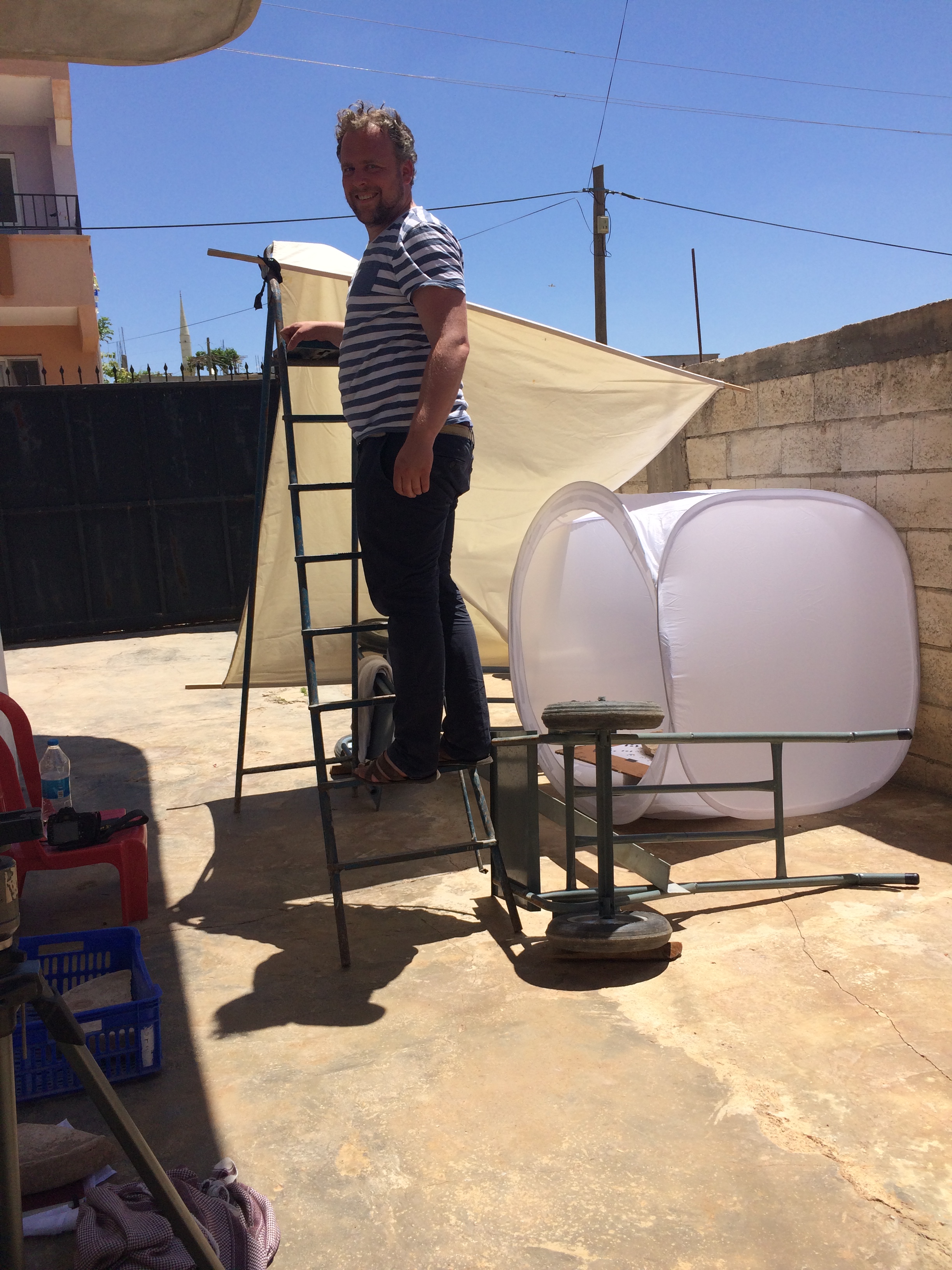
4b: …and Hajo taking photos (photo J. Meister).
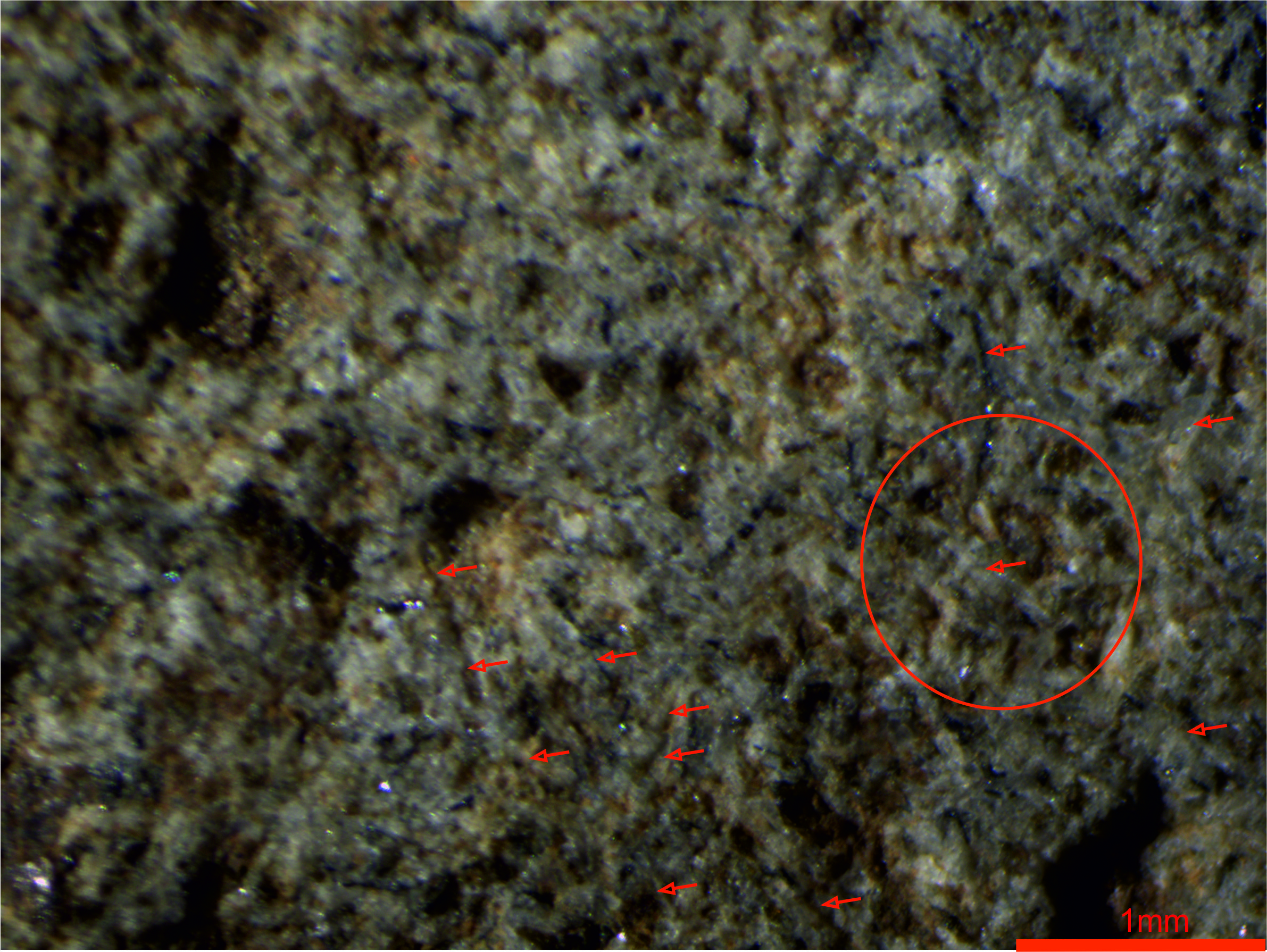
5: Microscopical use-wear of a handstone used most probably for processing einkorn (photo L. Dietrich),

6: …and me analyzing it (photo J. Meister).
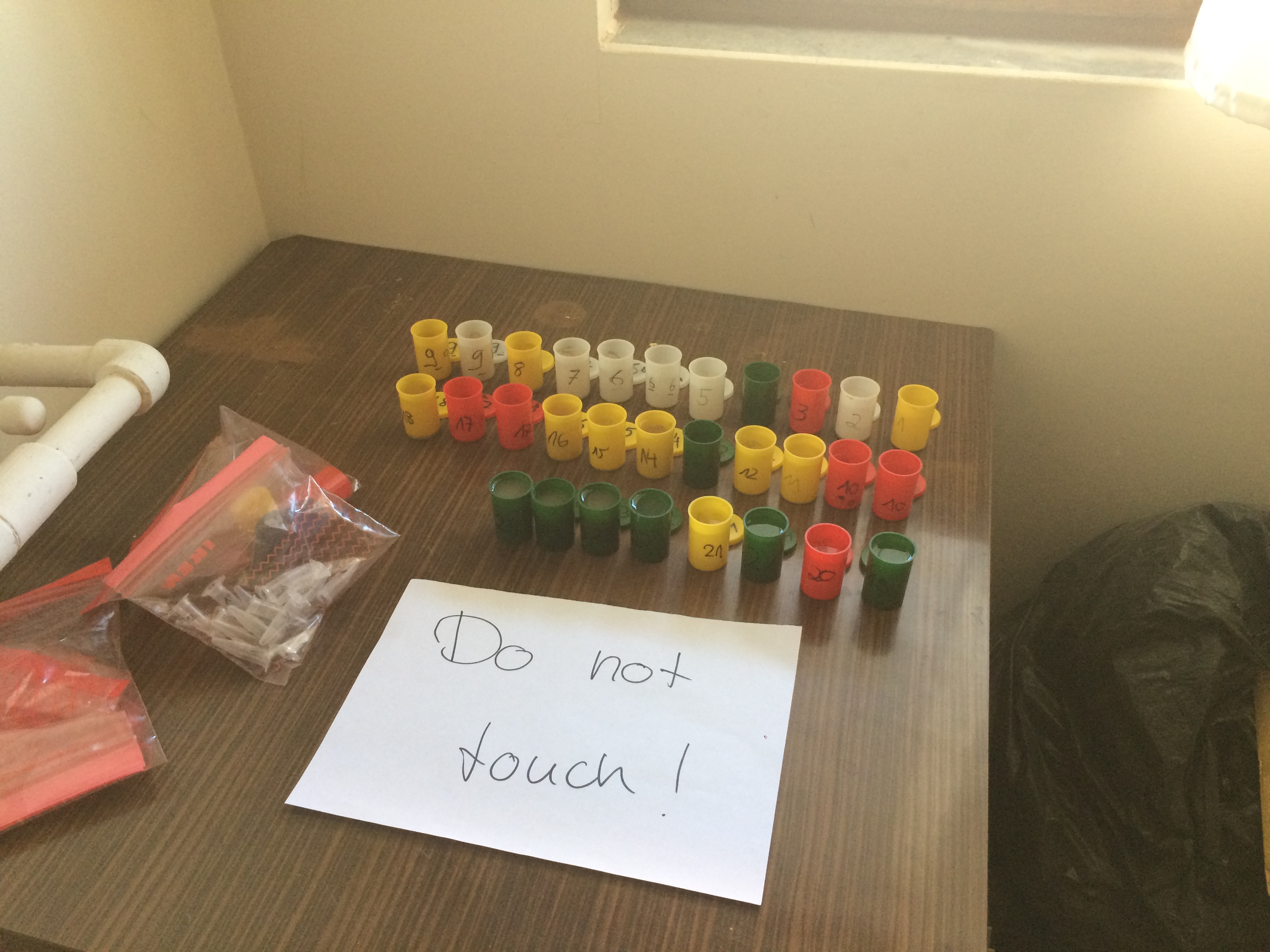
7a: Complementary to use wear: sediment samples (photo J. Meister),
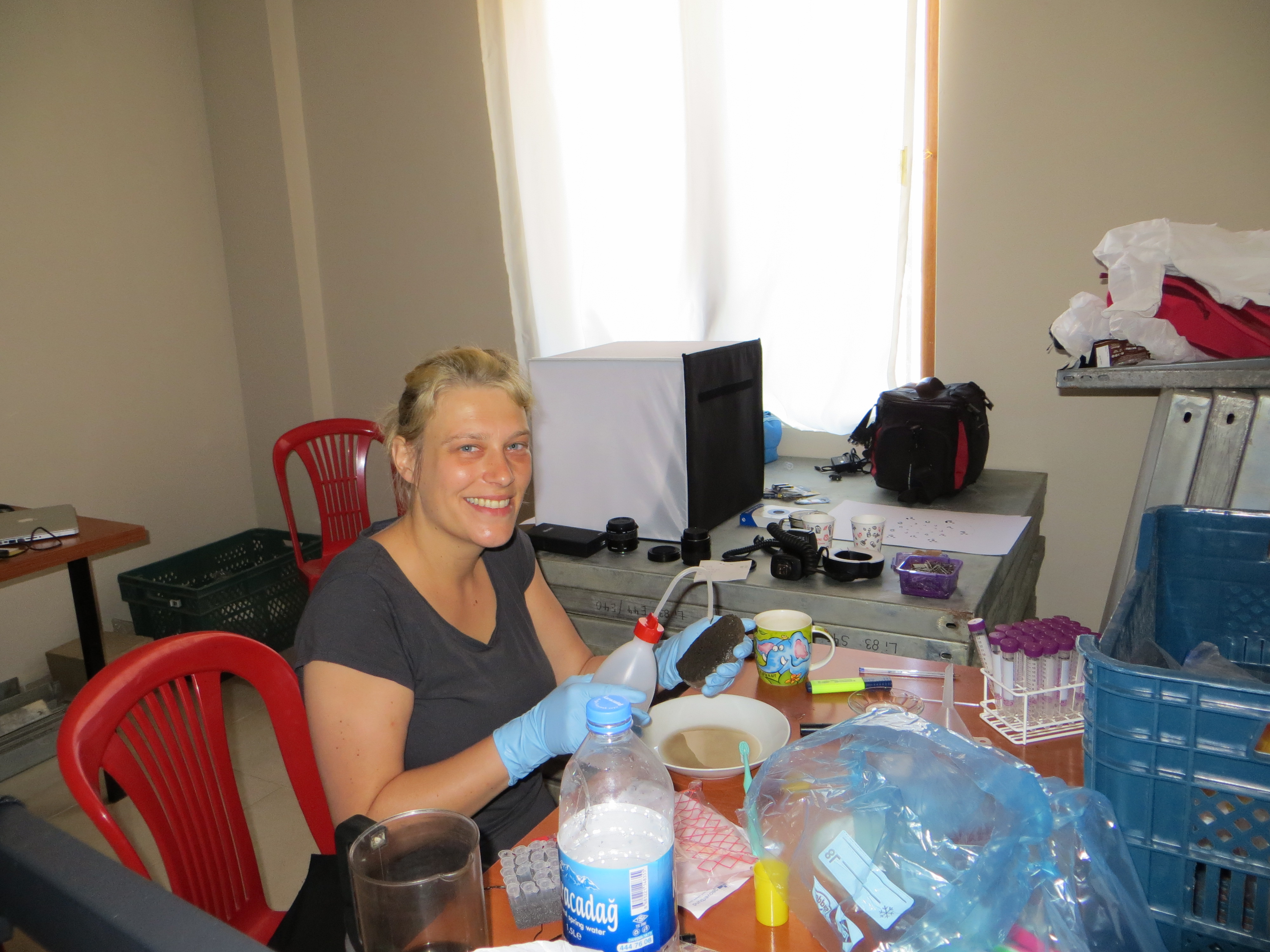
7b: …and Julia taking them (photo L. Dietrich)

8: …but also resting in the sunset after a lot of work done! (photo L. Clare)

9a: Back in Berlin: producing experimental grinding stones (photo L. Dietrich),
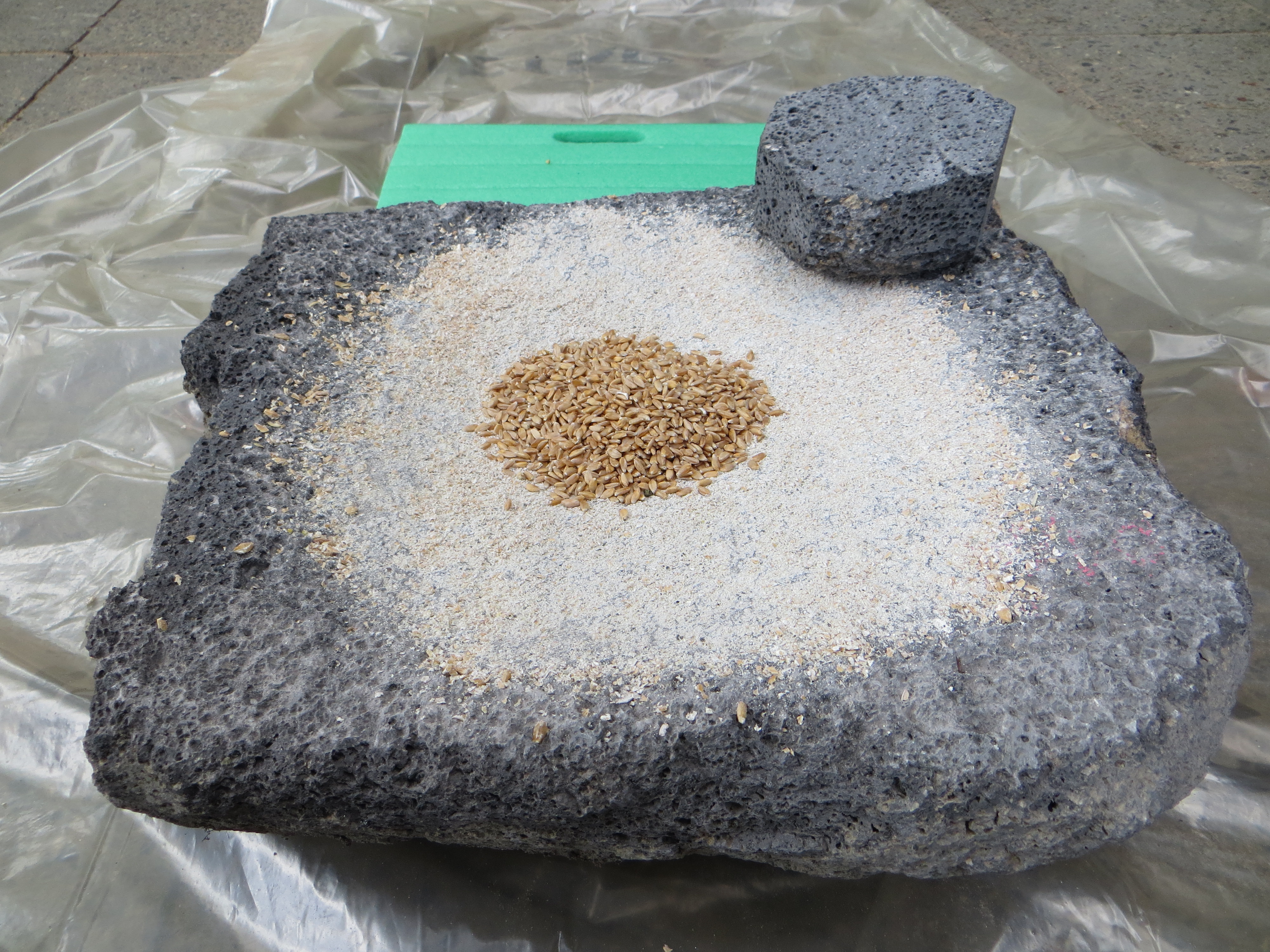
9b: …of the type used at Göbekli Tepe (photo N. Schäkel),
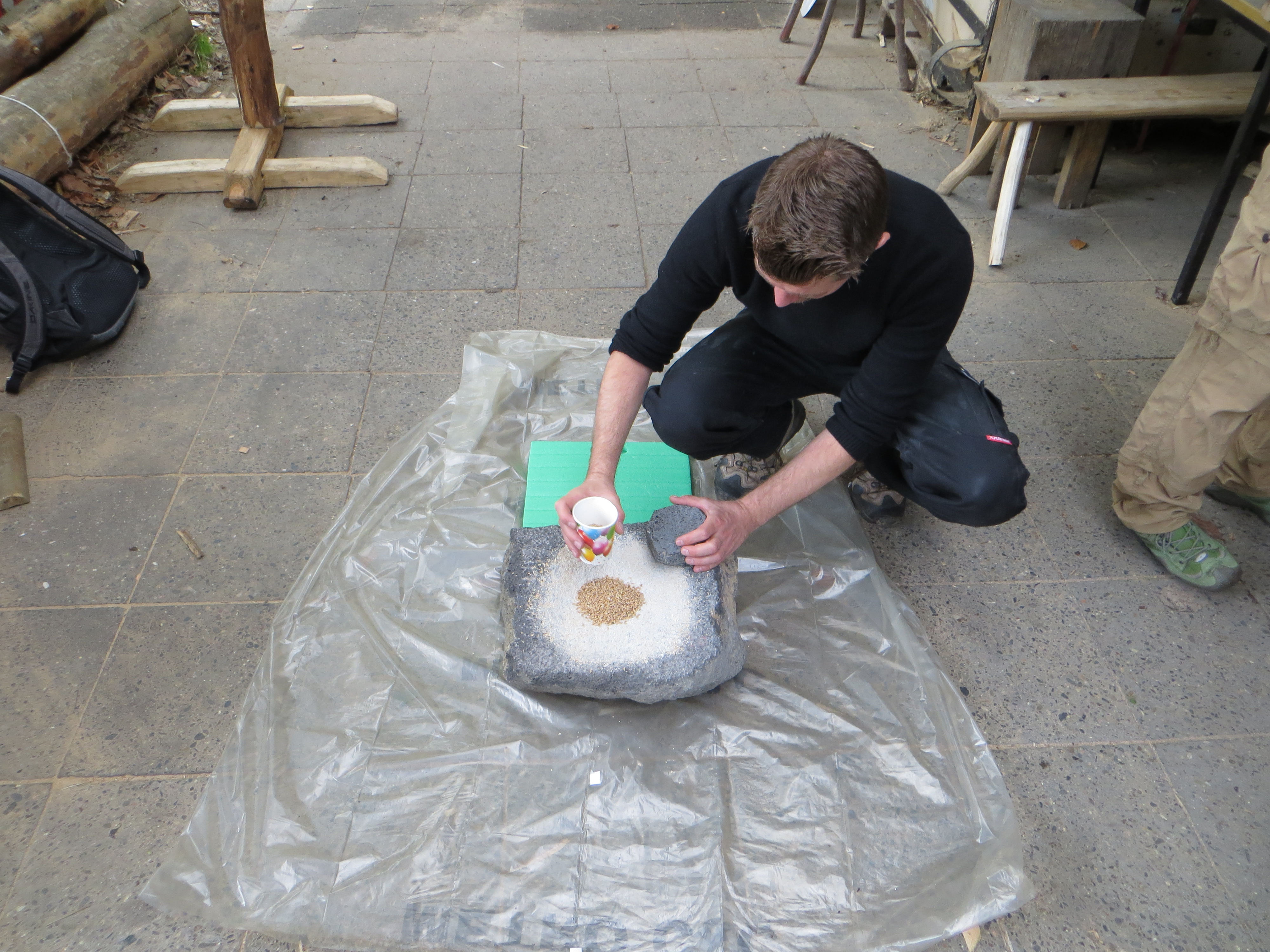
9c: …grinding einkorn, grinding, and grinding (photo B. Kortmann),

10: …and starting to study use-wear again (photo B. Kortmann)!
And finally: preparing first papers…which is the most exciting part of research!
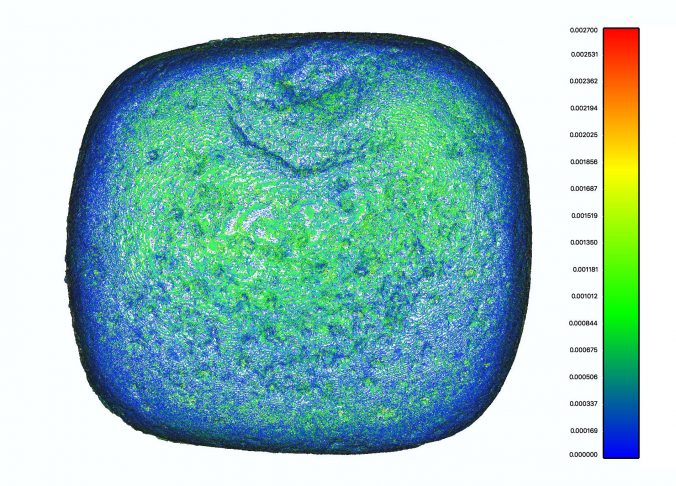
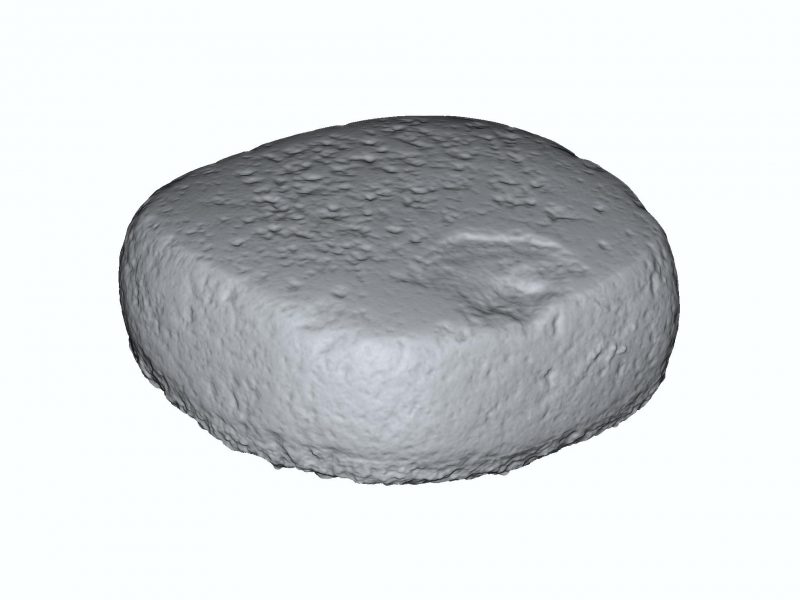
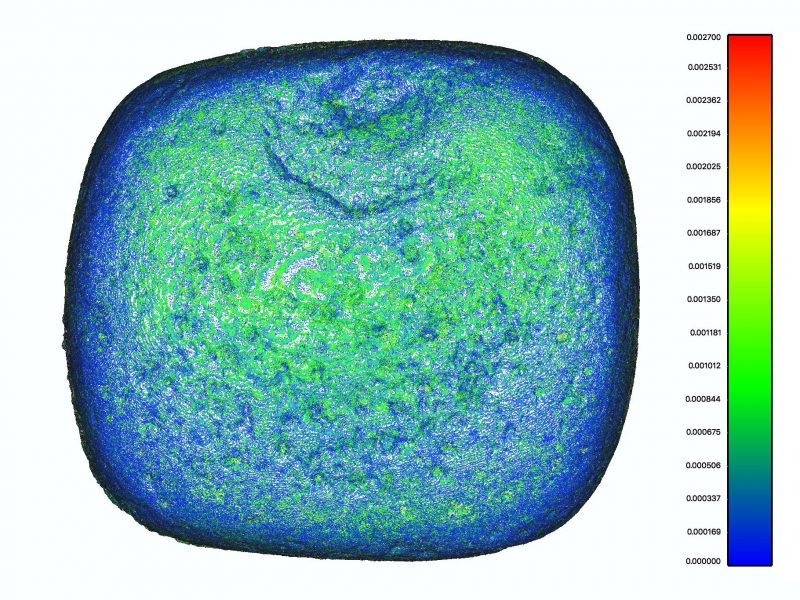
Fascinating! Keep up the good work! Looking forward to ongoing results.
Could you please tell us what the storage vessels were made of, and say something about their capacities. Also on the matter of storage, how do you intend to model potential storage in containers made of perishable materials such as skins and baskets.
On another matter, 10,00 grinding stones sounds a lot, but these include both handstones and grindstones. What is the ratio of handstones to grindstones?, How many would have in been in use at any one time?, what are their useful life-spans? How do they change over time, both in form and in usage? Do you also have mortars and pestles?
Finally, is there any evidence for the grinding of bones?
I realize that none of these are easy questions, and do not expect you to be abale to provide answers at this early stage in the research,
Geoff
Thanks for your interest and the many questions. I will approach them one by one:
1. Limestone, some of more than 200 liters.
2. This is a good question and a general issue in archaeology. I am not aware of a sound method to do that.
3. 1:3.
4. You can´t tell at the moment due to Göbekli Tepe´s complex site formation.
5. This will be one of the results of the ongoing experiments.
6. This will be a major outcome of the ongoing project.
7. Yes.
8. No.
Very exciting research.
Current status and development reported clearly and concisely.
Look forward to future updates….
Hi Laura,
Pls can you tell me what the evidence is for a more or less permanent group at GT. I had thought it was a seasonal feasting camp (possibly funerary rituals etc) , rather than semi-permanent.
best,
STEF
This is just a question of terminology. What I mean is that people had to spend a considerable amount of time at the site to build the enclosures and to accumulate surplus for feasting events.
Exactly. Structures like these weren’t built in a few weeks. Further investigation needs to be made of the surrounding area for evidence of prolonged occupation. There should be middens and firepit remains at the least.
Yes, they certainly were not build in day, but the task is not beyond the possibilities of hunter-gatherers. We have a few thoughts on that, see e.g. here: https://www.researchgate.net/publication/312686120_Feasting_Social_Complexity_and_the_Emergence_of_the_Early_Neolithic_of_Upper_Mesopotamia_A_View_from_Gobekli_Tepe
i mean rather than permanent! 🙂
Wouldn’t the large amount of discarded food processing/grinding equipment itself suggest more than just annual meat- feast gatherings? Wouldn’t it also suggest a nearby settlement where processing took place?
Yes. The current model is not necessarily about annual feasts. And much food would be needed also for construction work and maintenance.
Hi Laura,
I didn’t see this reply before.. tks.. If the current model isn’t about annual feasts or seasonal use then what is it?
Clearly, much food would be needed for construction but wouldn’t that pale into insignificance, when compared to decades of use? Presumably, if people travelled from afar seasonally, they would bring food for themselves and the ‘caretakers’ who may be have been on site more permanently?
As far as I am aware, the only previously published zoo-archaeological data confirmed likely seasonal use (late summer-autumn). But, Laura, if there is evidence to support another model, pls can you share it?
best,
STEF
please see above
Hi Laura,
This may be a silly question, but do you think they were primarily gathering wild plant foods, or using domesticated plants? If domesticated, were they growing food nearby, or bringing it from somewhere else?
That … is the million-dollar question. How could hunter-gatherers manage to feed a workforce large enough to build these structures? Further, how could the surrounding environment sustain such a hunter-gatherer workforce? Even though there has to-date been no evidence for agriculture, I believe there MUST have been some form of farming or livestock in the not-too-distant area. DNA analysis of grinding stone and storage container residue might reveal some evidence of domesticated grains. If so, this would be yet another re-write of the timeline for agriculture.
http://www.ancient-origins.net/artifacts-other-artifacts/what-mysterious-handbag-seen-ancient-carvings-across-cultures-and-021191
Does anyone have any theories about the designs at the top of pillar 43?
This (for want of a better description) water bag or purse object motif seems to occur across a wide variety of later cultures from Persia, Mesopotamia, and even Mayan. As seen in the link above.
Any comment welcome.
As Laura is in the field at the moment, let me respond with a link to a post about P 43: //dainstblog.com/2016/10/14/of-animals-and-a-headless-man-gobekli-tepe-pillar-43/
Best wishes,
Oliver
I thoght in handbag too… but then I saw pictures of ovens reconstruted at catal hoyuk and its looks more correct acordind to an interrelation betwen the animals and the trhee objets.
What is blowing my ind is that kind of fence behind… Where they keeping flying birds inside fences? What is that design depicting?
Thank you for your response.
Can you tell me what the animals are at the top of pillar 43? It is diffucult to make out but perhaps a bird on the right? A boar or perhaps lion in the middle? And no idea on the left?
However, how does that fit with:
“The image range of the different enclosures is far from random. In Enclosure A snakes are the dominating species, in Enclosure B foxes are frequent, in Enclosure C many boars are represented, while Enclosure D is more varied, with birds playing an important role. ”
Or, do you consider the middle animal to be a fox?
Thanks,
From left to right: a bird (crane), a snarling predator (possibly a wildcat), a reptile.
The symbols don´t have to be related necessarily to the excavated enclosures. There are at least ten more large buildings hidden in the ground (probably more), as georadar surveys show. The latest excavated addition to the list is Enclosure H, which has a lot of jumping wildcats.
Thank you for your response. Great point about future excavations turning up other animal associations.
I found a better photo, and see what appears to be a decapitated bird with a human head where the birds head would be mentioned in your article. Is this correct?
I notice the lifeless look to the birds legs others have mentioned that all the animals have that you pointed out was contradicted by the depiction of erect penis.
My question is two fold: First, what about the loin cloth appearing to be the tail and rear legs of a fox or other pelt? Couldnt this mean the hands were covering a similar loincloth rather than genitals? Second, what about priapisms-erections after death?
The right most figure is still difficult for me to discern even from the better photo. It appears a bit similar to the larger scorpion depicted on the pilar. Doesn’t it have too many legs to be a reptile? I’m sure you are in a better position to know but, can you please tell me what species reptile are you seeing?
Thank you,
Well I’m embarrassed by everything I write. The bird on the left appears intact in a different photo, and yes I see a frog or reptile head down on the right. What looked like 6 legs was a photo artifact.
Ist eigentlich bekannt, was für ein Klima während der Erbauung des Göbekli-Tepe-Tempels dort herrschte? Dieses Gebiet wird doch immer “Fruchtbarer Halbmond” genannt. Wie kann man sich die Vegetation und Tierwelt zur damaligen dort vorstellen?
Zweite Frage: Es ist immer von Pflanzenüberresten/Mahlsteinen die Rede. Sind am oder im Göbekli Tepe schon jemals Tierknochenreste oder menschliche Knochen gefunden worden? Oder zerfallen solche organischen Substanzen über diese grosse Zeitspanne?
Hallo, Göbekli-Tepe-Team, wäre dankbar, wenn jemand mal meine Frage beantworten würde!!!!
Danke
Ihre Frage, die Sie unter zwei Artikeln gestellt haben, ist bereits beantwortet worden. Bitte hier im Kommentarbereich nachsehen: //dainstblog.com/2017/11/09/factcheck-its-on-the-internet-so-it-must-be-true-right
Hi Laura/Oliver,
I’m still not very clear about the ‘model’ to which you refer. What evidence is there for semi-permanence at the site apart from an assumption the actual time spent building means semi-permanent dweller/builders? In terms of a surplus, visitors might have brought food with them for feasts? Or is seasonal feasting no longer the MOST likely scenario?
best,
STEF
This latest discussion raises a number of issues that are probably not answerable, but may nevertheless be of interest.
With regard to feasting, why should it be annual, or seasonal, or even regular? Feasts might have taken place for a number of different reasons that are not mutually exclusive, such as death and body disposal, with very different numbers of participants. I see no obvious way of approaching this issue with the evidence currently available although it should be possible, at least in theory, to get some kind of window on seasonality through plant and animal remains.
The number of people permanently resident is very difficult. It might be correct to assume the presence of some small group that possessed the skills and expertise to build and sculpt, but we know that T-shaped pillars are found on other sites. Construction and sculpting may not have been continuous but either seasonal or associated with events, or both.
I should know, but do not, if anyone has considered the possibilities that both the architecture and the sculpting were in wood at other sites, for instance in the mountains to the north of Adıyaman (from where Harold Hauptman published a phallus that he was surely correct in identifying as belonging to the Gobekli tradition). Are the stone sculpting techniques entirely different from those that would have been used for timber, or is one adapted from the other?
Finally, anything that was brought to the site had to be carried or dragged by manpower, there being no pack animals for another several thousand years. Thus stone tools, foodstuffs, and anything else was carried- presumably in baskets, bags and skins or possibly dragged on sleds of some kind. How much could (or would) one adult walking to the site over several days have been able carry? Such questions have been asked elsewhere, e.g. for obsidian at Çatal Höyük, but they seem to be very difficult to answer. It would seem, however, that there was some means of supplying Gobekli. It seems to me highly unlikely that people would have carried with them sufficient food for several days over and above what they might have required for the journey itself. One question, then, is how to assess what might have been accumulated by a resident population, what might have been supplied by groups in the vicinity (perhaps no more than one day = 20km distant), whether groups in the vicinity were permanently settled, and how much might have been brought over larger distances (both spatial and temporal). My guess is that there was some kind of organized supply, an ability to organize not being in doubt.
Thanks for your comment and sharing your thoughts with us. Regarding your questions:
In this case it’s the animal bones, in particular the slaughter age of gazelles which hint at seasonal feasts. Since gazelles (and other animals) usually fawn around the same time of the year, the fact that a large part of gazelle bones at Göbekli Tepe seem to come from rather young animals may hint at a certain seasonality.
No examples of related wooden sculptures or architecture have been found yet. This is not really surprising considering local preservation conditions. That said, it does indeed seem not unlikely (and I personally would expect this) that the stone carvings somehow are related or go back to similar objects originally cut and carved in wood. The technique and overall appearance makes this absolutely possible (in particular with a view to such spectacular yet exceptional finds as the so-called Shigir idol from the Middel Urals).
“With regard to feasting, why should it be annual, or seasonal, or even regular?â€
In this case it’s the animal bones, in particular the slaughter age of gazelles which hint at seasonal feasts. Since gazelles (and other animals) usually fawn around the same time of the year, the fact that a large part of gazelle bones at Göbekli Tepe seem to come from rather young animals may hint at a certain seasonality.
Thank you, Jens, for your helpful replies. While it must be correct that the age profile of gazelle (and other) bones demonstrates seasonal kill offs, just as similar profiles do for domestic species in later times. But is it equally the case that the meat is all consumed immediately after the kills rather than, for instance, being dried and stored? Would there be a way of approaching this question from the bone evidence? I can see that you could construct a model in which communal seasonal hunting of these young animals was followed by the meat being taken to Göbekli by the hunters and their kin for feasting. But would that mean that there were only annual feasts associated with hunting? One point of my question concerns how frequently and in what numbers non-residents visited Göbekli. Was there really a large seasonal increase? What might have been the human catchment area? How could we estimate population density across the landscape? On a different tack, how might a model that saw hunting and related feasting fit in with the ideas that Klaus had about Göbekli in relation to disposal of the dead? I understand that this question moves away from hard archaeological evidence towards discussion of the symbolism.
I think it important to raise these kinds of questions (even if they are unanswerable) when thinking, for instance, about populating the landscape, human impact (e.g. from hunting), and the stimuli to domestication that was to follow.
Food storage usually is not a peculiar characteristic of (mobile) hunter-gatherer groups, particularly with a view on meat provisions. At least this is not archaeologically visible in the material record (yet). Historic and ethnographic records give us indeed the idea that this kind of subsistance is more often than not based on a ‘from hand to mouth’ strategy (you simply don’t need to worry about long-term storage when you’re literally following your food). That’s also what is so remarkably about the Göbekli Tepe monuments and supposed feasting: accumulating and providing enough food to supply these events. That’s also an important insight Laura’s research here may offer: that vegetable aliment may have played a much more important role than we might have assumed.
Your questions are indeed valuable and valid. To be honest, we actually did ask all of these ourselves too. And we even tried to answer many of these. Regarding numbers of people, catchment area, disposal of the dead etc. pp. see for instance:
Dietrich et al., The Role of Cult and feasting in the Emergence of Neolithic Communities. New Evidence from Göbekli Tepe, South-eastern Turkey, Antiquity 86, 2012, 674-695.
Notroff et al., Building Monuments – Creating Communities. Early monumental architecture at Pre-Pottery Neolithic Göbekli Tepe. In: J. Osborne (Hrsg.), Approaching Monumentality in the Archaeological Record. Albany: SUNY Press (2014), 83-105
Notroff et al., Gathering of the Dead? The Early Neolithic sanctuaries of Göbekli Tepe, Southeastern Turkey, in: C. Renfrew, M. Boyd and I. Morley (Hrsg.), Death shall have no Dominion: The Archaeology of Mortality and Immortality – A Worldwide Perspective. Cambridge: Cambridge University Press (2016), 65-81.
Of course there are many possible scenarios one could come up with and think about, but in the end we’re still archaeologists and this means we somehow have to stick to the archaeological record when we’re building our models. Everything else might be a great lesson in thought experiments, but would leave the solid ground of archaeology as scientific discipline.
Thank you!
I will read the papers that you cite the last two of which, rather unfortunately, I confess to not hiving seen.
Geoff
‘Death shall have no Dominion’ is ,sadly, very expensive in the UK.
Unfortunately it is. Even we could not afford to buy any book or journal covering important news and research about our fields of interest. But fortunately, there are libraries.
Hi Jens,
How close was the gazelle annual migration path to Gobekli Tepe? Gazelle’s might have learned that e.g. pistachio nuts were ready to eat there before humans or not?
best,
STEF
Naturally that would be hard to answer. They certainly went by through the valleys, but where exactly I can‘t say. They didn‘t really leave us a path or something like that, so we would need more subtle hints like actual butchering sites, prominent depcitions etc. pp. (and these would be better assumptions only, too, at best).
Have you tried analyzing any residue left on the grinding stones? It would be interesting to see what kind of DNA might be left on them after 10,000 years.
DNA preservation ist bad at GT. We have analysed phytolits, results are upcoming.